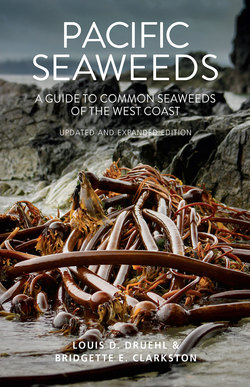Читать книгу Pacific Seaweeds - Louis Druehl - Страница 63
На сайте Литреса книга снята с продажи.
ОглавлениеGreen Seaweeds | 63
Identifying Pacific Seaweeds
or fan-shaped, variously lacerated or perforated and reach a length of 1 m (3 ft) but is usually less than 30 cm (12 in). The colour may vary from very pale to emerald green. Often the margins of these plants are white in contrast to their otherwise rich green. The white portions are cells that have discharged their contents as spores or gametes, leav-ing only the cellulose cell walls. In our area, large blades with holes, formerly classified as U. fenestrata (Latin= window), are now known to belong to either U. “lactuca” or U. rigida.
Ulva flourishes where there are rich nutrient conditions. Sometimes, growth gets out of hand, resulting in what is called green tide. An extreme example of this phenom-enon occurs in Venice Lagoon, Italy, where nutrients from Venice sewage and surrounding farmlands support an extraordinary wild monoculture of Ulva. When the waters warm up, the Ulva population depletes all available oxygen and begins to rot, resulting in a nauseating rotten-egg smell. Up to 200 metric tonnes (220 tons) of Ulva are harvested daily, eight months of the year, to combat this situation.
Habitat & Distribution
Plants exist throughout the intertidal and subtidal regions and in tide pools. This genus is perhaps the most cosmopolitan of all seaweeds, being found on all of the world’s coasts. In our region, bladed species of Ulva are distrib-uted from Alaska to Mexico.
Ulva sp. washed ashore at Monterey Harbor.
Ulva sp. and cross-sec-tion (right) showing two cell layers.
